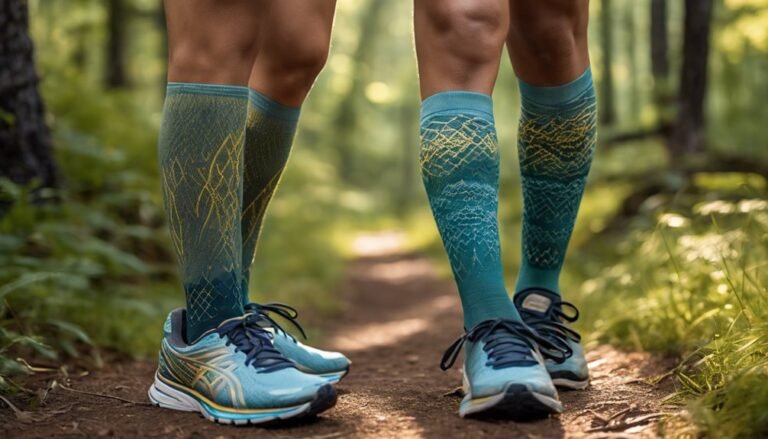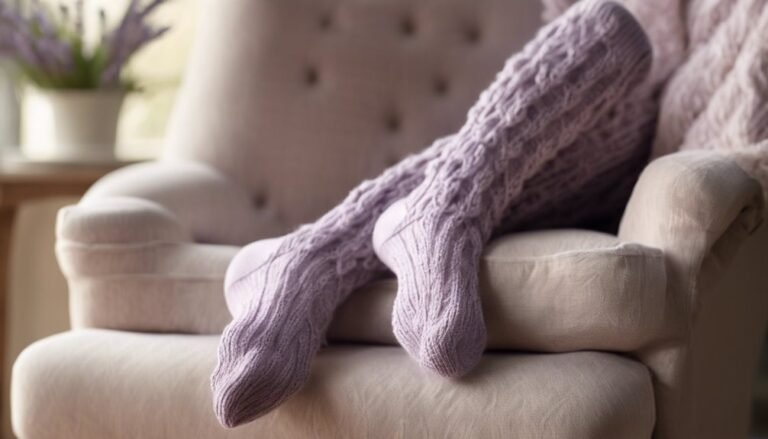Are Wool Socks Sustainable? The Truth About Sheep & the Environment
Wool socks can be sustainable, but it all hinges on the methods used in sheep farming. When raised with care, sheep contribute to a renewable resource, offering breathable and biodegradable socks. However, issues like overgrazing can harm the environment. Ethical practices and responsible sourcing are essential for ensuring wool's sustainability. If you want to uncover more about wool's life cycle and its environmental impact, there's a wealth of information waiting for you.
The Life Cycle of Wool: From Sheep to Sock

When you think about wool socks, it's easy to overlook the intricate journey that wool takes from sheep to your feet. Wool harvesting begins with caring for the sheep, ensuring their welfare is prioritized. Healthy sheep produce high-quality wool, reflecting their living conditions. Shearers, trained in humane techniques, collect the fleece, minimizing stress for the animals. Once harvested, the wool undergoes cleaning and processing, transforming it into the soft fiber you love. This journey highlights the importance of ethical practices in wool production. By choosing wool socks from responsible sources, you support sheep welfare and sustainable practices. In doing so, you embrace a lifestyle that values freedom—not just for you, but also for the animals that contribute to your comfort.
Environmental Impact of Sheep Farming
When you consider the environmental impact of sheep farming, two key factors come into play: land use and water consumption. You might be surprised to learn how much land is required to raise sheep, which can lead to habitat loss and soil degradation. Additionally, the water needed for these farms raises concerns, especially in regions already facing scarcity.
Land Use Considerations
While sheep farming is often celebrated for its contributions to sustainable materials like wool, the environmental impact of land use cannot be overlooked. Poor grazing practices can lead to significant land degradation, threatening not just the local ecosystem but also the viability of future sheep farming. Overgrazing strips the land of vegetation, resulting in soil erosion and loss of biodiversity. It's essential to reflect on how sheep farmers manage their land. Sustainable grazing techniques, like rotational grazing, can mitigate these effects, allowing for healthier soil and more resilient ecosystems. By supporting practices that prioritize land health, you can enjoy your wool socks while knowing you're contributing to a more sustainable future. Your choices matter, and they can influence how land is used in sheep farming.
Water Consumption Issues
Although wool socks are often praised for their sustainability, the water consumption associated with sheep farming presents a significant environmental challenge. You might be surprised to learn that sheep farming requires substantial water usage, primarily for drinking and irrigation practices in pasture management. This demand can strain local water resources, especially in arid regions where water scarcity is already a pressing issue. With increasing awareness about sustainable practices, it's essential to reflect on how much water is used to raise sheep for wool. If you value freedom in your choices, you'll want to understand the broader impact of your purchases. Ultimately, while wool has its merits, the water consumption involved raises important questions about the true sustainability of wool socks.
The Wool Processing Journey
As you explore the journey of wool processing, you'll discover a meticulous transformation that begins with shearing and concludes with the creation of high-quality socks. Initially, raw wool is collected, and its fiber quality is assessed to guarantee it meets industry standards. Next, the wool undergoes cleaning, removing grease and impurities. This is followed by carding, where fibers are aligned, creating a soft, uniform base for spinning. During the spinning process, the wool is twisted into yarn, enhancing its strength and durability. Finally, dyeing adds color, and knitting turns the yarn into cozy socks. Each step is crucial in maintaining fiber quality, ensuring that what you wear is not only comfortable but also a product of careful craftsmanship and sustainable practices.
Benefits of Choosing Wool
When you choose wool socks, you're opting for a material that's naturally insulating, keeping your feet warm in winter and cool in summer. Plus, wool's biodegradable and renewable nature means it's a more sustainable choice compared to synthetic fabrics. With excellent moisture-wicking abilities, wool helps keep your feet dry and comfortable, making it an ideal option for any activity.
Natural Insulation Properties
Choosing wool socks not only elevates comfort but also provides exceptional natural insulation properties that set them apart from synthetic alternatives. Wool's unique thermal regulation keeps your feet warm in cold conditions while allowing for breathability features that prevent overheating. This means you can enjoy outdoor adventures without worrying about sweaty, damp feet. The fibers trap air, creating a natural barrier against the elements, ensuring you stay cozy and dry. Plus, unlike synthetic materials, wool can wick moisture away from your skin, enhancing your overall comfort. By opting for wool socks, you're embracing a holistic approach to your wardrobe—one that celebrates both functionality and the environment, giving you the freedom to explore without compromising on comfort or sustainability.
Biodegradable and Renewable
Wool isn't just a comfortable choice; it's also a remarkably sustainable one. When you choose wool socks, you're opting for biodegradable benefits that support a healthier planet. Wool naturally decomposes, enriching the soil instead of contributing to landfill waste. Additionally, wool is a renewable resource, as sheep grow new fleece every year, ensuring a sustainable supply without depleting the earth's resources.
| Feature | Wool | Synthetic Materials |
|---|---|---|
| Biodegradability | Yes | No |
| Renewable Resource | Yes | No |
| Environmental Impact | Low | High |
Moisture-Wicking Abilities
While many materials may claim to keep your feet dry, few can match the moisture-wicking abilities of wool. Wool fibers can absorb moisture without feeling wet, allowing your feet to breathe while effectively regulating temperature. This means that even if you sweat, wool's natural moisture retention properties keep your feet comfortable and dry. You won't have to worry about clammy socks ruining your day outdoors. Additionally, wool helps to maintain an ideal temperature, whether it's cold or warm, making it an ideal choice for various activities. When you choose wool socks, you're not just opting for comfort; you're embracing a natural solution that enhances performance and freedom in your adventures. Experience the difference that quality wool can make!
Criticisms of the Wool Industry

Although many appreciate the warmth and durability of wool socks, the wool industry faces significant criticisms that can't be overlooked. Concerns about animal welfare are at the forefront, with reports of mistreatment during shearing and inadequate living conditions for sheep. Many consumers are increasingly demanding industry transparency, wanting to know how their wool is sourced and whether ethical practices are followed. Unfortunately, not all brands provide this information, which leaves many feeling uneasy about their purchases. The lack of stringent regulations can lead to exploitative practices that contradict the values of those seeking sustainable options. As you explore your choices, it's essential to contemplate these issues and advocate for greater accountability within the wool industry.
Making Sustainable Choices in Wool Products
When considering ethical and sustainable options for your sock collection, it's important to look beyond just the warmth and comfort that wool offers. Start by researching sustainable brands committed to ethical sourcing practices. These brands prioritize animal welfare, ensuring sheep are treated humanely and sustainably. Look for certifications like Responsible Wool Standard, which guarantees that the wool is produced with respect to the environment and animal rights. Also, consider the lifecycle of the products; choose durable options that minimize waste. By supporting brands that align with your values, you're not only investing in quality but also contributing to a more sustainable future. Remember, your choices can empower change in the wool industry and promote responsible consumerism.
Frequently Asked Questions
How Do Wool Socks Compare to Synthetic Socks in Sustainability?
When you compare wool socks and synthetic ones, consider wool's natural, biodegradable properties against synthetic's environmental impact. Wool production often supports ecosystems, while synthetics contribute to pollution, making wool a more sustainable choice overall.
Are There Certifications for Sustainable Wool Products?
Yes, there are several sustainable certifications for wool products, like Responsible Wool Standard and Global Organic Textile Standard. These guarantee eco-friendly practices in farming and processing, helping you make informed, sustainable choices for your wardrobe.
What Is the Lifespan of Wool Socks?
Think of your favorite pair of socks—wool's durability shines through. With proper care, wool socks last several years, offering moisture-wicking benefits and warmth. You'll appreciate the long-lasting comfort they provide, making them a wise choice.
Can Wool Socks Be Recycled or Composted?
You might wonder if wool socks can be recycled or composted. Wool recycling is possible, and composting wool is effective, as it biodegrades naturally, enriching the soil while reducing waste. Sustainability is within your reach!
How Do I Care for Wool Socks Sustainably?
Imagine slipping on cozy wool socks, cradling your feet like a warm embrace. To care for them sustainably, wash gently in cold water, then air dry to preserve their softness and longevity—keeping your feet happy!







